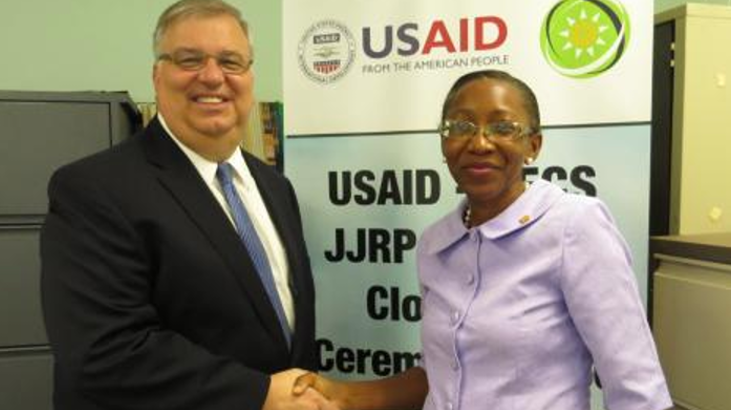España/25 de junio de 2016/Fuente: http://www.caribbeannewsnow.com/
Resumen:
Proyecto de USAID aumenta la resistencia de Granada ante el cambio climático
La capacidad de Granada para mitigar los riesgos del cambio climático derivados de las tormentas, huracanes, sequías y otros fenómenos meteorológicos extremos se ha mejorado por el proyecto de cinco años, de $9.5 millones denominado, Reuniendo a la Región a la Acción sobre el Cambio Climático (RRACC) implementado por la Agencia de Estados Unidos para el Desarrollo Internacional (USAID), en colaboración con la Organización de Estados del Caribe Oriental (OECO). El director de la misión de USAID para el Este y Sur del Caribe, Christopher Cushing, cerró oficialmente fuera del segmento de Granada del proyecto en una ceremonia el día miércoles. USAID proporcionó $ 1.3 millones en asistencia para mejorar la resistencia general del país y ayudar a las comunidades en la reducción de los riesgos relacionados con el clima sobre sus vidas y medios de vida a largo plazo.
En virtud de la iniciativa RRACC, y en respuesta a las inquietudes planteadas por los residentes sobre el impacto de la subida del nivel del mar, un dique fue construido en Petite Martinique para amortiguar las ondas fuertes y mitigar la erosión del litoral durante las tormentas. Una rehabilitación integrada de cuencas hidrográficas y la iniciativa de las zonas costeras en la comunidad Sauteurs dieron como resultado el desarrollo de un plan de adaptación al cambio climático de la comunidad, que se centró en la replantación de árboles en las cuencas hidrográficas y las zonas costeras erosionadas por la acción del oleaje. El ejercicio de reforestación Sauteurs incluyó la siembra de más de 100 árboles en la Rodney Playa Monte por alumnos de la Escuela de McDonald Colegio secundario, el ministerio de la agricultura, la tierra, la silvicultura y la pesca, y los miembros de St Patrick comunitaria ambiental Organización de Turismo (Spectro). el proyecto RRACC también mejoran la capacidad de la granadina, proporcionando herramientas y equipos, construcción de viveros para la propagación de plantas, y la instalación de un sistema de recogida de aguas pluviales para garantizar la disponibilidad de agua durante los períodos secos.
_________________________________________________________
ST GEORGE’S, Grenada — Grenada’s capacity to mitigate climate change risks stemming from storms, hurricanes, droughts and other extreme weather events has been enhanced by the five-year, $9.5 million Rallying the Region to Action on Climate Change (RRACC) project implemented by the United States Agency for International Development (USAID) in collaboration with the Organization of Eastern Caribbean States (OECS).
USAID mission director for the Eastern and Southern Caribbean, Christopher Cushing, officially closed out the Grenada segment of the project at a ceremony on Wednesday,. As part of the project, USAID provided $1.3 million in assistance to improve the country’s overall resilience and assist communities in reducing climate-related risks to their lives and livelihoods over the long term.
Under the RRACC initiative, and in response to concerns raised by residents about the impact of sea level rise, a seawall was built in Petite Martinique to buffer strong waves and mitigate coastline erosion during storms. An integrated watershed rehabilitation and coastal area management initiative in the Sauteurs community resulted in the development of a community climate change adaptation plan, which focused on replanting trees in watersheds and along coastal areas eroded by wave action.
The Sauteurs reforestation exercise included the planting of over 100 trees on the Mount Rodney Beach by students from the McDonald College Secondary School, the ministry of agriculture, land, forestry and fisheries, and members of St Patrick’s Environmental Community Tourism Organization (SPECTRO).
The RRACC project also enhanced the capacity of the Grenadian government’s forestry nursery in Grand Etang by providing tools and equipment, constructing nursery beds for plant propagation, and installing a rainwater harvesting system to ensure water availability during dry periods.
“As a result of these projects, Grenada’s capacity, knowledge base, and ability to adapt to and mitigate future climate risks (particularly for coastal communities) were significantly improved,” Cushing said. “Sauteurs and Petite Martinique represent only two of the region’s many vulnerable communities, but can serve as models to demonstrate successful adaptation measures.”
Acknowledging Grenada’s economic dependence on coastal resources like mangroves, sandy beaches, sea grasses and coral reefs — all of which are particularly vulnerable to climate-related threats like sea level rise, changing temperatures and increased salinity — Cushing noted that the project was a positive example of the strides that can be made when governments and ordinary citizens work together to bring about positive change.
“This project also underscores the US government’s strong commitment to helping Grenada and the broader region to adapt to more frequent and severe storm events, periods of drought, and other impacts of climate change,” Cushing said.
Charge D’Affaires with the US Embassy in Grenada, Steve Framm, greets Merina Jessamy , Permanent Secretary with responsibility for Agriculture, Lands and the Environment during the RRACC ceremony
Fuente de la Noticia:
Source: USAID project boosts Grenada’s resilience to climate change





 Users Today : 47
Users Today : 47 Total Users : 35459953
Total Users : 35459953 Views Today : 53
Views Today : 53 Total views : 3418518
Total views : 3418518